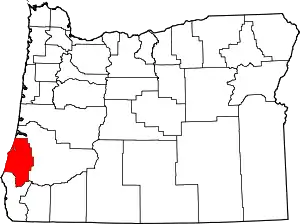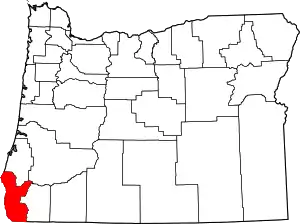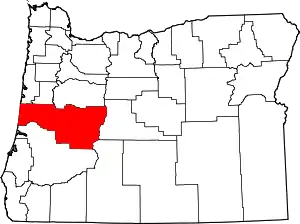Confederated Tribes of Coos, Lower Umpqua and Siuslaw Indians
The Confederated Tribes of the Coos, Lower Umpqua and Siuslaw Indians of Oregon are a federally recognized Native American tribe of Hanis Coos, Miluk Coos, Lower Umpqua (or Kuitsh), and Siuslaw people in Oregon.[4] They are indigenous peoples of the Plateau.
 Drawing of an Umpqua man | |
| Total population | |
|---|---|
| 526 (1990s)[1] | |
| Regions with significant populations | |
| Languages | |
| English, formerly Coos,[2] Siuslaw,[3] and Kuitsh (Lower Umpqua)[1] | |
| Religion | |
| Traditional Tribal Religion | |
| Related ethnic groups | |
| Other Coos, Lower Umpqua, and Siuslaw people |
Lands
The service area of the Confederated Tribes of the Coos, Lower Umpqua and Siuslaw Indians include lands a five-county area spanning Coos, Curry, Lincoln, Douglas, and Lane Counties.[4]
Government

The Confederated Tribes of the Coos, Lower Umpqua and Siuslaw Indians are headquartered in Coos Bay, Oregon. The tribe is governed by a democratically elected general council, serving four-year terms. The tribal chief serves ten-year terms. The current tribal government leadership is as follows:
- Chief: Warren Brainard
- Chairman: Doc (Don) Slyter
- Vice-Chairman: Mark Petrie
- Councilperson: Debbie Bossley
- Councilperson: Iliana Montiel
- Councilperson: Doug Barrett
- Councilperson: Josh Davies[5]
Languages
Members of the Confederated Tribes of Coos, Lower Umpqua and Siuslaw speak English. Formerly they spoke the Coos language and Siuslaw language (Siuslaw and Kuitsh dialects), which is a language isolate.[3] The tribe runs a language program to revive Coos and Siuslaw.[2]
Economic development
The Confederated Tribes of Coos, Lower Umpqua and Siuslaw owns and operates:
- Three Rivers Resort, a Class 3 Facility in Florence, Oregon.[6]
- Three Rivers Casino, a Class 2 Facility in the Empire District of Coos Bay, Oregon.
- Blue Earth Services and Technology
History
The tribes did not have contact with Europeans until 1792. In 1828, Lower Umpqua (Kuitsh) people massacred members of the Jedediah Smith Party and attacked the Hudson's Bay Company's fort in 1838.[1] Most of their population died in the epidemics which followed European contact.[7]
In 1860 the remnants of these and other tribes were forced onto the Siletz Reservation. The reservation was split into three parts, with one section being opened to non-native settlement and another becoming the Alsea Reservation, which was opened to non-native settlement in 1875.[8]
The Confederated Tribes of Coos, Lower Umpqua and Siuslaw formally organized in 1916.[8] They adopted their first constitution in 1938[9] and ratified their current constitution in 1987.
Notes
- Pritzker 172
- "Coos." Ethnologue. Retrieved 8 Sept 2013.
- "Siulaw." Ethnologue. Retrieved 8 Sept 2013.
- "About Us." Archived 20 August 2016 at the Wayback Machine Tribes of Coos, Lower Umpqua and Siuslaw Indians. 2013. Retrieved 8 Sept 2013.
- https://ctclusi.org/tribalcouncil
- "Three Rivers Casino & Hotel." 500 Nations. Retrieved 8 Sept 2013.
- Robert T. Boyd, The Coming of the Spirit of Pestilence: Introduced Infectious Diseases and Population Decline among Northwest Coast Indians. page 132. Seattle, WA: University of Washington Press, 1999. https://books.google.com/books?id=jnWMCaFcuM4C&pg=PA132&source=gbs_toc_r&cad=4#v=onepage&q&f=false accessed 20 November 2013.
- Pritzker 173
- Pritzker 174
References
- Pritzker, Barry M. A Native American Encyclopedia: History, Culture, and Peoples. Oxford: Oxford University Press, 2000. ISBN 978-0-19-513877-1




